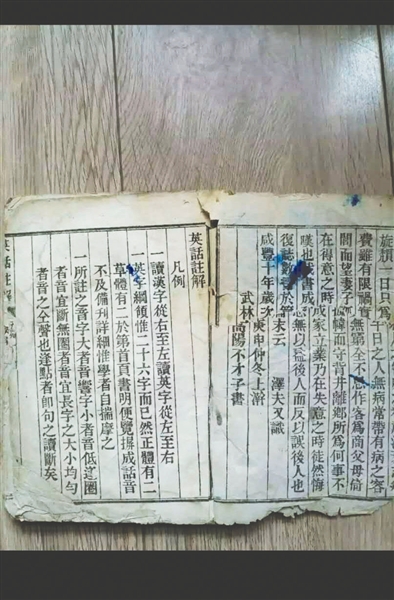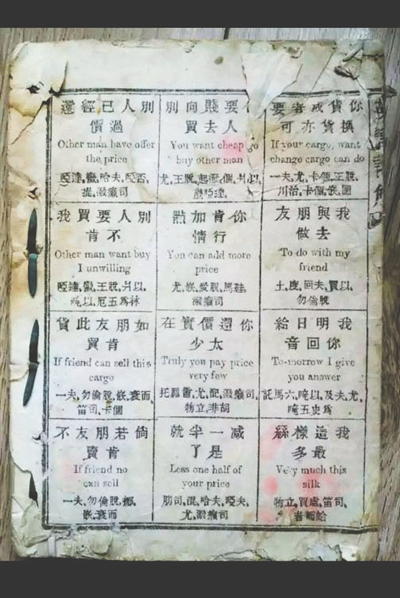China people learned English this way more than 150 years ago.

It is inferred from the appearance and content that the English book of such an ancestor should belong to the Qing Dynasty. Experts believe that if it is a good book, then this book has scientific research value.

The English book of our ancestors was read in this way, and 12 small squares were drawn. Each square was filled with an English sentence, with Chinese sentence patterns at the top, English sentence patterns in the middle and Chinese phonetic notation at the bottom. These phonetic symbols were all replaced by Chinese characters.
It’s not garbled, it’s "phonetic symbol"
tomorrow i give you answer to do with my friend
Tuo Ma Liu, Yi Yi, He Fu, You, Yi Wu Shi Wei, Tu, Du, Hui Fu, Buy Yi, Don’t forget.
"Tuo Ma Liu, Yi Yi, and Fu, You, Yi Wu Shi Wei", "Tu, Du, Hui Fu, Buy Yi, Don’t leave" … … These illogical words are superimposed together, which makes many people think that they are garbled. In the late Qing Dynasty, when there was no repeater, English pronunciation depended on these garbled words.
Yesterday, Mr. Yao, a citizen of Chengdu, showed a collection of English textbooks printed with the words "Ten Years of Xianfeng". The words "garbled" on them correspond to English sentences, namely "tomorrow i give you answer" and "to do with my friend". According to experts from the Western Sichuan Literature Restoration Center, it is inferred from the printing, font and content of this book that the English book should be authentic and belong to the late Qing Dynasty. However, due to the lack of physical objects for the time being, it is impossible to infer the specific age. Some experts in modern history say that the phenomenon of Chinese phonetic learning English is very common in modern times.
Pronunciation of Chinese Characters The Qing Dynasty "tried to figure it out" when learning English.
Seven or eight years ago, Mr. Yao, a citizen of Chengdu, scoured a pile of old books from the second-hand book market in Chongqing, and one of them, a book in traditional Chinese characters without a cover, aroused his interest. "There are English letters under the traditional Chinese characters." Mr. Yao told reporters that this book has forty or fifty pages, turning from left to right. The first few pages contain the words "Ten Years of Xianfeng" (1860).
At the beginning of the English Annotations Catalogue, there are marked categories such as Geography Gate, Monarch Gate, Mentor Gate, Palace Gate, Hardware Gate, etc. In the book, 12 small squares are drawn, each with an English sentence pattern at the top, an English sentence pattern in the middle and Chinese phonetic notation at the bottom. These phonetic symbols are all replaced by Chinese characters.
Some English pronunciations marked with Chinese characters now look ridiculous. For example, "just reduce by half" is translated as "Less one half of your price", and the British standard is marked with Chinese characters as "Li Si, Meng, Huff, Dumb Man, You, Pu Si". Mr. Yao said that foreigners would definitely not understand it if they read it according to such pronunciation.
At the beginning of the textbook, there is also a "Instructions for Use": "Chinese characters are read from right to left, and English characters are read from left to right" … … And the author is also at the beginning of the friendship tips learning tips, "only scholars try to figure it out."
The pronunciation is very strange. The Chinese character should be "Mandarin" in the late Qing Dynasty.
After seeing the photos of the books, Mr. Peng from the Institute of Ancient Books of Sichuan University said that they should be books in the late Qing Dynasty, but the exact time cannot be judged. Experts from the Western Sichuan Literature Restoration Center also said that according to the photos of the book, it should be inferred from the appearance and content that this book belongs to the Qing Dynasty, but because it has not been exposed to paper and objects, it is still impossible to judge whether this book is a rare book or a later copy. "Many foreign books have been translated in succession during the Qing Dynasty." According to experts, the rare edition was engraved earlier and circulated less. If it is a rare edition, then this book has scientific research value.
Reading these English short sentences according to the pronunciation marked by these Chinese characters is very strange to read. So, how to read this kind of Chinese phonetic notation?
Lei Hanqing, a professor at Sichuan University who is proficient in linguistics, believes that this kind of Chinese phonetic notation mainly appears in less formal textbooks, and the teachers will guide the tone, while the Chinese characters in the textbooks are mainly tips for beginners. "The late Qing Dynasty also had its own ‘ Yayan ’ 、‘ Guoyin ’ (equivalent to Mandarin). " Lei Hanqing concluded that, because of the capital of Beijing, the standard dialect at that time should be close to the pronunciation of Beijing dialect, and we can also know from some videos of Puyi’s speech that the pronunciation difference is not too big. In other words, if you travel more than 150 years ago, you can still understand the local people.
Rise/know/know
The Qing people called English nonsense.
Foreigner: Their pronunciation is terrible.
In fact, the learning method of using Chinese characters as English phonetic notation has existed for a long time in modern times.
Dr. Sun Guangping, who studies the history of cultural exchanges between China and the West, introduced in an article about the development of English textbooks in the late Qing Dynasty. At that time, English textbooks were divided into three stages. The embryonic stage was mainly from 1807 to 1840. At the trading ports in China, some China people’s own learning textbooks were popular, mainly pidgin English textbooks, to meet the needs of Chinese and foreign trade. These textbooks are all in Chinese for English phonetic notation, which is convenient for China people to learn.
At the beginning of Sino-British trade, we had to rely on Portuguese who can speak Cantonese or China who can speak Portuguese as an intermediary to communicate. At that time, a booklet called Ghost Story was popular in Guangzhou, in which the pronunciation of "man" was replaced by "man" and today was marked as "land". Samuel Wells Williams, an American missionary, commented on the "poor pronunciation" of English in these pamphlets.
From 1840 to 1895, English teaching developed. Under the impetus of the Westernization Movement, some western-style schools appeared. In an English textbook written by Americans, phonetic symbols were used to mark the pronunciation of English letters. The third stage was after the failure of the Sino-Japanese War in 1895, when some original English textbooks were introduced.
It is reported that during the reign of Kangxi, after the signing of the Treaty of Nebuchadnezzar Chu, the Qing Dynasty began to pay attention to talents proficient in Russian and Latin, and during the reign of Yongzheng, the translated language of Hua Yi reappeared in the rivers and lakes. This official dictionary of China’s early modern foreign language translation into Chinese has all foreign language entries in Chinese phonetic notation.
Chengdu Business Daily reporter Huan Xiaohuai
The picture is provided by respondents.